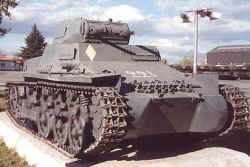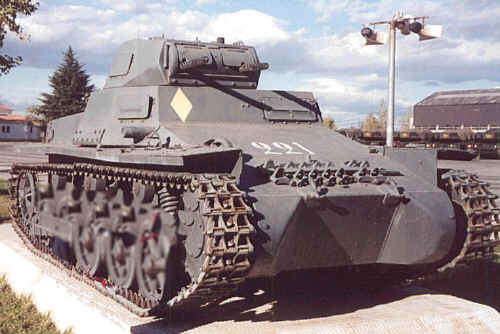 |
|
|
Armor |
|
|
Panzerkampfwagen I Historical overview Part I |
|
|
by Patricio Delfosse © 2001 |
|
|
Legal Notice No material from Modeler Site any Web site owned, operated, licensed, or controlled by Mario Covalski & Associated may be copied, reproduced, republished, uploaded, posted, transmitted, or distributed in any way, except that you may download one copy of the materials on any single computer for your personal, non-commercial home use only, provided you keep intact all copyright and other proprietary notices. Modification of the materials or use of the materials for any other purpose is a violation of Mario Covalski & Associated's copyright and other proprietary rights. Read More here > Legal notice In accordance with the Versailles treaty signed after the First World War, Germany was not allowed to develop any armored vehicles. However, its close cooperation with Russia from 1921 on made it possible to perform tests with these vehicles in Russian territory, at the Test Center in Kazan (from 1926). Along with these tests, some research work was made in subsidiary companies of the biggest German firms located in foreign countries (Austria for example) and other companies like the Swedish Landswerk Company. Almost in secret, the German engineers became to acquire experience in the design of armored vehicles, which will render its profits some years later with the development of the well known final series of combat vehicles. But the beginnings were modest. Oswald Lutz called for a bid for the manufacture of an armored vehicle in 1932, he prepared the specifications for a small vehicle (five tons) and was not tempted by ambitious and unattainable projects. The well-known German meticulousness took its first step. Heinz Guderian, who was working closely to Oswald Lutz, would later be recognized as one of the founders of the armored weapon. According to the theories exposed by these two men, it was necessary to have a light armored vehicle to serve a dark and underestimated purpose: train the future Panzer troops. The big combat Panzers would come later. A request for a preliminary project was sent to Rheinmetall Borsig, Krupp (Essen), Henschel (Kassel), MAN (Nürnberg), and Daimler Benz (Berlín), and after analyzing all proposals received, the development of the prototypes was requested in 1933. The one finally chosen was the LKA 1 from Krupp, although it was very similar to its competitors. It was officially called "LaS" (Landwirtschaftlichter Schlepper, or light tractor for agriculture) in order to conceal its true purpose, opposed to the terms of the Treaty of Versailles.
Curiously, this vehicle which would be the first armored vehicle to be put into service by the Reichswehr and which would be the predecessor of the future successful German armored vehicles, was based on an English tank. In effect, Russia purchased in 1929 two Vickers Cardon-Loyd Mk. VI (based on which it would develop the T-27), which were sent in secret to the Germans in 1932. One version of the suspension of these English vehicles would be adapted to the needs of the Panzer I. In the summer of 1933 five LaS units were sent to Kummersdorf in order to be evaluated and the decision was made to mount the superstructure of the Daimler Benz design on the hulls designed by Krupp. After all tests made until February 1934, it was decided that an improved LKA 1 (LaS) would enter into production in April. This vehicle was officially called Panzerkampfwagen I Ausf. A (Sd.Kfz. 101), although it bore the temporary name MG Panzerwagen-Versuchkraftfahrzeug 617 (test vehicle 617). Initially, a batch of 15 units was manufactured, which were presented to Hitler by Heinz Guderian himself. The first 150 units were released in July 1934 by Henschel.. Panzer IA The PzKpfw I Ausf. A (Sd.Kfz. 101) was manufactured with armored steel plates, which thickness varied from 6 and 13 mm, completely welded. This was a big progress compared to the hulls built with rivets, since it could best support the impact of the antitank shots. The hulls built with rivets literally disassembled upon receiving a direct hit, the rivets would go off and would become dangerous projectiles. Originally, the engine was a Krupp 305, air refrigerated by four cylinders set in a boxer configuration. It had 3458 cc and produced just 60 hp at 2500 rpm. In spite of the light weight of the vehicle (5,4 t) and as a result of the poor power-to-weight ratio (11,1 hp/t), the performance of this vehicle was not remarkable, with a speed of around 37 km/hr. In 1935/36 this installation was tested in an Ausf. A with a Krupp diesel engine, the M601, but it only reached 45 hp, for which reason the idea was abandoned. The crew was composed by the tank driver, who had an entrance door on the left side of the vehicle, and a commander who was overloaded with work. In addition to controlling the tactical situation and handle and reload the armament, he was also a radio operator. The available armament was inadequate, even for that time. It comprised two 7,92 mm MG13 located at both sides of a manually activated turret, with a turn of 360º. Both machine guns were calibrated in order to jointly aim at 300 m. This armament has no power in combat against other armored vehicles. It could only attacked infantry targets. Neither the driver nor the commander had any periscopes or visual equipment. Prewar The sports vehicle from Krupp - as the Panzer I Aus A was usually called by the crew - was not a good combat vehicle. Its thin armor would not have supported the direct impact of an anti-tank riffle. It did not have an adequate armament and its engine was not as powerful as it should have been. However, it fulfilled the expectations, training thousands of crews who found this vehicle the first one set in motion by tracks, and giving them basic tactical experience on a motorized combat vehicle. As important as this was the psychological effect produced by these small vehicles on the German people, who had not seen a significant demonstration of power since the end of the Great War. The parades in which the Panzer I units took part, along with the black uniforms of the troop, the beret with the skull and the youth of the crews, made them feel proud to belong to the Panzer troops. The first victories obtained during the campaigns in Poland, France and the Netherlands confirmed this feeling. From 1935 on, the Panzer I took part in every big parade of the Wehrmacht, especially on Hitler's birthday anniversary, the Reich day and the Wehrmacht day. They were commonly known as "black hussars" by the press and the public opinion, since they inherited from them the skull, the color of the uniform and their traditional role in the cavalry regiment. The following fragment taken from the hymn of the Panzer troops summarizes the spirit of that time:
Although it may snow or a stormy winds blow, although the sun may laugh at us, the day burns or night freezes us, dirty are our faces, happy is our though; our armor is templated by this stormy wind. We face the armed enemy with engines as speedy as a thunderbolt. Ahead of our comrades, in the battlefield, we are all alone; in this way we deeply penetrate the enemy lines. When the enemy appears, then we shoot and run to them. ¿What makes us give our lives for our Reich Army?: we would die for Germany with the highest honor. Panzer IB In August 1935, the production of an improved model - called Panzerkampfwagen I Ausf. B (Sd. Kfz. 101) - started. It presented a new engine, the Maybach NL 38 TR, with six cylinders in line, 3786 cc and 100 hp at 3000 rpm. An improved gear box, the ZF Aphon FG 31, was also introduced. Since the new engine was larger than the original Krupp, it was necessary to make the chassis longer by 43 cm and add a fifth wheel to the running gear. The opportunity was taken to improve the running, by raising the idler wheel. For which reason, although the chassis was now longer and a new wheel was added, the surface of the tracks in contact with the ground remained unchanged. As a consequence of these modifications, the weight of the vehicle raised up to 5,8 t. In spite of the higher power of the new engine, the Panzer I continued to be a vehicle with limitations, especially as regards armament and armor, in addition to having its autonomy restricted due to the higher consumption of the Maybach engine. Most of the units were manufactured by Henschel, but Wegamann also took part in this manufacture program, therefore a total number of 800 units were manufactured up to the end of 1935, reaching up to 1900 in service in 1939. Spain The baptism of fire of the Panzer I took place during the Spanish Civil War (1936-1938). Approximately 100 Ausf. A and B units, along with a small number of Kleiner Panzer Befehlswagen I were sent to form part of the Legion Condor, within the Panzer Abteilung 88 under Colonel Wilheim Ritter von Thoma, taking part in combat on the side of the nationalists of General Franco. These units were nicknamed "Negrillos", and demonstrated that they did not have the level of the soviet T-26 y BT-5 used by the republicans, although this comparison is not at all valid, since the soviet vehicles were true combat tanks equipped with powerful guns. During the war, a test was made with the Ausf. B by installing a 20 mm Breda gun on a modified turret, and in other cases a flame thrower was installed instead of the two machine guns. Other vehicles, captured by the republicans, were given a French 25 mm Hotchkiss gun mounted on a new turret. Despite all these efforts to introduce improvements, the operative use of these vehicles was more of an exercise, a way of putting into practice the theory of the Blitzkrieg, since this vehicle did not have enough merits for combat. At the end of the war, the surviving vehicles continued to be in service within the nationalist army.
World War II Despite their unadvisable use in combat, when the war broke out on September 1, 1939, these Panzer I units formed part of several first-line units of the Wehrmacht, being the most numerous armored vehicle among the different models available. In addition to being used by the nationalists in Spain, the Panzer units were exported to some countries. In 1934 Hungary purchased only one unit, and most probable other few in 1942 for training purposes. Also Finland and possibly Croatia, acquired Panzer I units. The most important purchaser was China, that acquired 10 Panzer I Auf A (together with other German vehicles) during the government of General Chiang Kai Shek at the end of the '30's Part II > Click here
|
|

